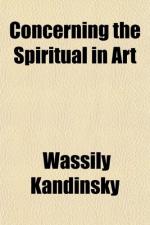On the other hand, the number is increasing of those men who put no trust in the methods of materialistic science when it deals with those questions which have to do with “non-matter,” or matter which is not accessible to our minds. Just as art is looking for help from the primitives, so these men are turning to half-forgotten times in order to get help from their half-forgotten methods. However, these very methods are still alive and in use among nations whom we, from the height of our knowledge, have been accustomed to regard with pity and scorn. To such nations belong the Indians, who from time to time confront those learned in our civilization with problems which we have either passed by unnoticed or brushed aside with superficial words and explanations. [Footnote: Frequently in such cases use is made of the word hypnotism; that same hypnotism which, in its earlier form of mesmerism, was disdainfully put aside by various learned bodies.] Mme. Blavatsky was the first person, after a life of many years in India, to see a connection between these “savages” and our “civilization.” From that moment there began a tremendous spiritual movement which today includes a large number of people and has even assumed a material form in the theosophical society. This society consists of groups who seek to approach the problem of the spirit by way of the inner knowledge. The theory of Theosophy which serves as the basis to this movement was set out by Blavatsky in the form of a catechism in which the pupil receives definite answers to his questions from the theosophical point of view. [Footnote: E. P. Blavatsky, The Key of Theosophy, London, 1889.] Theosophy, according to Blavatsky, is synonymous with eternal truth. “The new torchbearer of truth will find the minds of men prepared for his message, a language ready for him in which to clothe the new truths he brings, an organization awaiting his arrival, which will remove the merely mechanical, material obstacles and difficulties from his path.” And then Blavatsky continues: “The earth will be a heaven in the twenty-first century in comparison with what it is now,” and with these words ends her book.
When religion, science and morality are shaken, the two last by the strong hand of Nietzsche, and when the outer supports threaten to fall, man turns his gaze from externals in on to himself. Literature, music and art are the first and most sensitive spheres in which this spiritual revolution makes itself felt. They reflect the dark picture of the present time and show the importance of what at first was only a little point of light noticed by few and for the great majority non-existent. Perhaps they even grow dark in their turn, but on the other hand they turn away from the soulless life of the present towards those substances and ideas which give free scope to the non-material strivings of the soul.
A poet of this kind in the realm of literature is Maeterlinck. He takes us into a world which, rightly or wrongly, we term supernatural. La Princesse Maleine, Les Sept Princesses, Les Aveugles, etc., are not people of past times as are the heroes in Shakespeare. They are merely souls lost in the clouds, threatened by them with death, eternally menaced by some invisible and sombre power.




